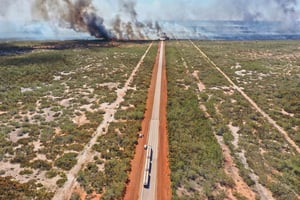
Case Study: Wildfire Impact on Dundas Freight & Supply Chain
CLIENT
Shire of Dundas in association with the Freight and Logistics Council of Western Australia and supported by the National Disaster Risk Reduction Grant Program.
WHAT WE DID
- Developed a wildfire severity hazard map and fuel model
- Identified critical infrastructure
- Analysed exposure and vulnerability of infrastructure and supply chains to wildfire
PROJECT INFORMATION
The Shire of Dundas in Western Australia spans a vast area and serves as a major stopping point for freight and travelers. This region faced immense challenges when wildfires blazed across 550,000 hectares of its land. Critical supply routes, including the Eyre Highway, faced disruptions.
A review by the State Emergency Management Committee of Western Australia spotlighted the vulnerabilities of these vital routes. The wildfires' aftermath led to a collaborative approach to manage future risks, with Geoneon leveraging high-resolution satellite imagery, elevation models, and analytics to provide an insightful vulnerability assessment.
CHALLENGES
- Massive geographical area for analysis, nearly 1.5 times the size of Tasmania
- High dependency on key supply routes for multiple services
- Significant implications on supply chains due to road vulnerabilities
- Need for integrating multifaceted data sources into actionable insights
RESULTS
Geoneon's work provided a comprehensive wildfire severity map, factoring in elements like vegetation cover, topography, and infrastructural assets. By integrating the spatial data with financial implications,
Geoneon offered a clear perspective on potential financial losses tied to wildfire severity. This tangible output aims to guide decisions on infrastructure protection and risk management, ultimately safeguarding Dundas's critical supply chains.
"This should be priority software for infrastructure owners and freight operators led by Emergency Management Organisations at State and Federal Government levels."

Peter FitchatChief Executive Officer, Shire of Dundas